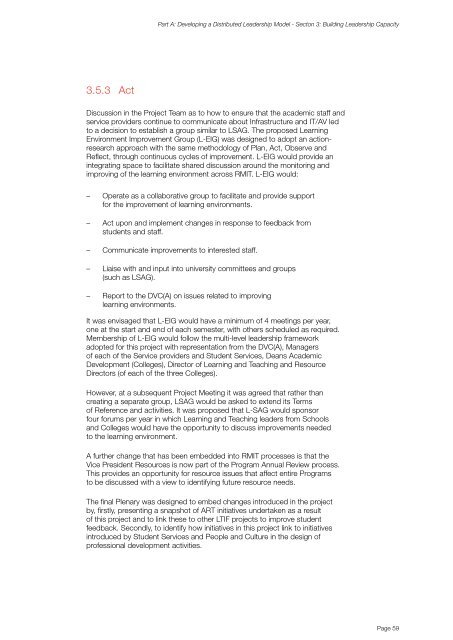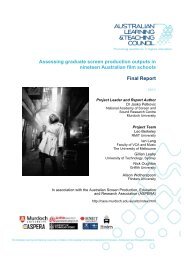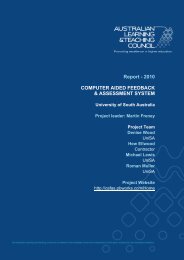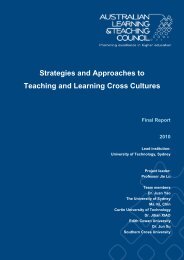student feedback and leadership - Office for Learning and Teaching
student feedback and leadership - Office for Learning and Teaching
student feedback and leadership - Office for Learning and Teaching
You also want an ePaper? Increase the reach of your titles
YUMPU automatically turns print PDFs into web optimized ePapers that Google loves.
Part A: Developing a Distributed Leadership Model - Secton 3: Building Leadership Capacity3.5.3 ActDiscussion in the Project Team as to how to ensure that the academic staff <strong>and</strong>service providers continue to communicate about Infrastructure <strong>and</strong> IT/AV ledto a decision to establish a group similar to LSAG. The proposed <strong>Learning</strong>Environment Improvement Group (L-EIG) was designed to adopt an actionresearchapproach with the same methodology of Plan, Act, Observe <strong>and</strong>Reflect, through continuous cycles of improvement. L-EIG would provide anintegrating space to facilitate shared discussion around the monitoring <strong>and</strong>improving of the learning environment across RMIT. L-EIG would:––Operate as a collaborative group to facilitate <strong>and</strong> provide support<strong>for</strong> the improvement of learning environments.––Act upon <strong>and</strong> implement changes in response to <strong>feedback</strong> from<strong>student</strong>s <strong>and</strong> staff.––Communicate improvements to interested staff.––Liaise with <strong>and</strong> input into university committees <strong>and</strong> groups(such as LSAG).––Report to the DVC(A) on issues related to improvinglearning environments.It was envisaged that L-EIG would have a minimum of 4 meetings per year,one at the start <strong>and</strong> end of each semester, with others scheduled as required.Membership of L-EIG would follow the multi-level <strong>leadership</strong> frameworkadopted <strong>for</strong> this project with representation from the DVC(A), Managersof each of the Service providers <strong>and</strong> Student Services, Deans AcademicDevelopment (Colleges), Director of <strong>Learning</strong> <strong>and</strong> <strong>Teaching</strong> <strong>and</strong> ResourceDirectors (of each of the three Colleges).However, at a subsequent Project Meeting it was agreed that rather thancreating a separate group, LSAG would be asked to extend its Termsof Reference <strong>and</strong> activities. It was proposed that L-SAG would sponsorfour <strong>for</strong>ums per year in which <strong>Learning</strong> <strong>and</strong> <strong>Teaching</strong> leaders from Schools<strong>and</strong> Colleges would have the opportunity to discuss improvements neededto the learning environment.A further change that has been embedded into RMIT processes is that theVice President Resources is now part of the Program Annual Review process.This provides an opportunity <strong>for</strong> resource issues that affect entire Programsto be discussed with a view to identifying future resource needs.The final Plenary was designed to embed changes introduced in the projectby, firstly, presenting a snapshot of ART initiatives undertaken as a resultof this project <strong>and</strong> to link these to other LTIF projects to improve <strong>student</strong><strong>feedback</strong>. Secondly, to identify how initiatives in this project link to initiativesintroduced by Student Services <strong>and</strong> People <strong>and</strong> Culture in the design ofprofessional development activities.Page 59
















